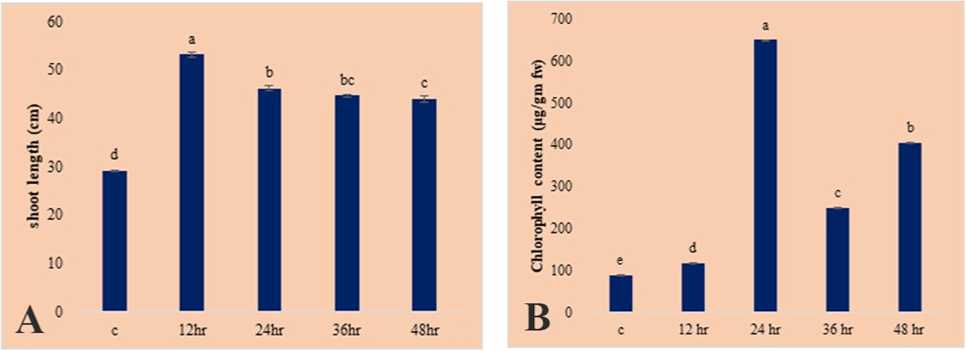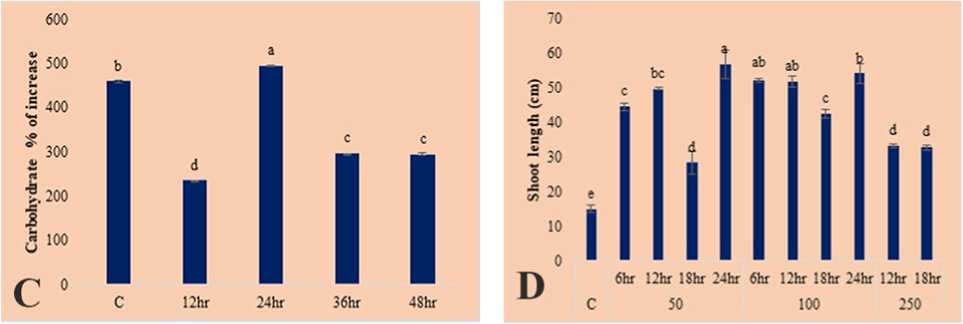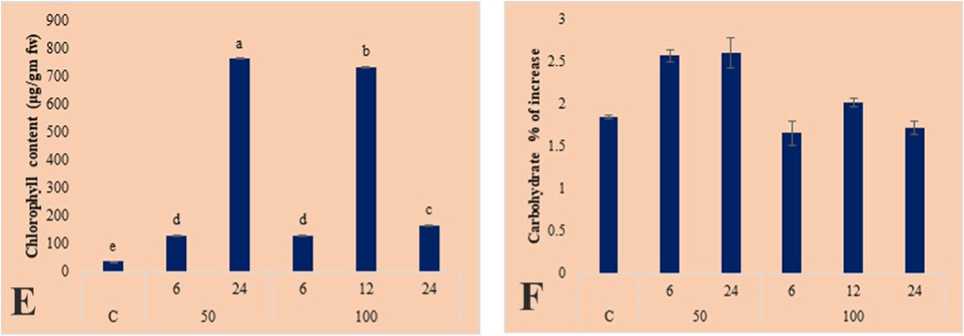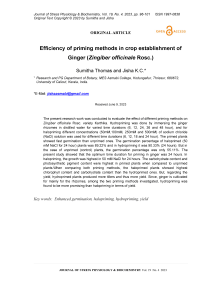Efficiency of priming methods in crop establishment of ginger (Zingiber officinale Rosc.)
Автор: Sumitha T., Jisha K.C.
Журнал: Журнал стресс-физиологии и биохимии @jspb
Статья в выпуске: 4 т.19, 2023 года.
Бесплатный доступ
The present research work was conducted to evaluate the effect of different priming methods on Zingiber officinale Rosc. variety Karthika. Hydropriming was done by immersing the ginger rhizomes in distilled water for varied time durations (6, 12, 24, 36 and 48 hour), and for halopriming different concentrations (50mM,100mM, 250mM and 500mM) of sodium chloride (NaCl) solution was used for different time durations (6, 12, 18 and 24 hour). The primed plants showed fast germination than unprimed ones. The germination percentage of haloprimed (50 mM NaCl for 24 hour) plants was 89.22% and in hydropriming it was 90.33% (24 hours). But in the case of unprimed (control) plants, the germination percentage was only 55.11%. The present study showed that the optimum time duration for priming in ginger was 24 hours. In halopriming, the growth was highest in 50 mM NaCl for 24 hours. The carbohydrate content and photosynthetic pigment content were highest in primed plants when compared to unprimed plants.When comparing both priming methods, the haloprimed plants showed highest chlorophyll content and carbohydrate content than the hydroprimed ones. But, regarding the yield, hydroprimed plants produced more tillers and thus more yield. Since, ginger is cultivated for mainly for the rhizomes, among the two priming methods investigated, hydropriming was found to be more promising than halopriming in terms of yield.
Enhanced germination, halopriming, hydropriming, yield
Короткий адрес: https://sciup.org/143180993
IDR: 143180993
Текст научной статьи Efficiency of priming methods in crop establishment of ginger (Zingiber officinale Rosc.)
Ginger ( Zingiber officinale Rosc.) is a cash crop mainly cultivated for its spicy rhizomes (Jayasree et al ., 2015). It is consumed freshly as vegetable and in dried form. Ginger is highly aromatic and hence, widely used as a flavouring agent in many dishes. In Kerala, it is a rain-fed crop (March-December), and for harvest, it needs 230-245 days after planting. In this large duration from planting to harvest, the plant victimises various climate and temperature fluctuations. If these are not carefully managed, it will affect the crop yield (Kandiannan et al., 1996; Jalaja et al., 2016). Although, ginger has resistance against wind and drought, it is susceptible to icy, saline and water logging conditions (Kandiannan et al., 1996 Jayasree et al., 2015; Liu et al., 2022).
Priming is the best cost-effective method that getting widely acceptance in the area of plant stress management (Balestrini et al., 2016) and uniform emerging of seedling is the best quality of primed plants (Sen and Puthur, 2020). Priming is the pre-germination technique usually used in seed plants (Sen and Puthur, 2020; Jisha and Puthur, 2014; Shahri et al., 2015). But only very few earlier priming works has been done with ginger rhizomes. In the work of Ghosh (2015), ginger rhizomes were primed with salicylic acid and assessed the resistance against Pythium infection through SAR induction. Jalaja et al., (2016) carried out biopriming of ginger with Trichoderma viride for the production of ginger in off-season and they found that the bio-primed rhizomes showed better establishment. Pre-treatment of rhizomes before planting is recommended for early germination and for reducing the emergence of seed borne diseases. Farmers in Kerala usually routinely soak the rhizomes in cow dung emulsion for preventing the attack of Sclerotium rolfsii. Moreover, intermittent smocking of rhizomes and immersing the rhizomes in hot water at 40˚C for 20 minutes before planting is also practicing in ginger cultivation (Kandiannan et al., 1996).Various plant breeding methods has done to improve the large production of ginger. In the tissue culture method, Vasala (2012) reported that, tissue cultured plants required more than two years for better ginger production, so the tissue culture method is not recommended for yield enhancement in ginger. In this current research work, we evaluated the differential efficacy of hydro and halopriming of ginger on its sprouting, growth, number of tillers, and yield.
MATERIALS AND METHODS
Soil preparation and site of study
Present experiment was performed in M.E.S Asmabi College, Kodungallur, West costal area of Thrissur District, Kerala, India. Soil of the experiment plot was prepared with soil and sand with 2:1 ratio. The soil was tested before the planting of rhizomes at Radiotracer laboratory, College of agriculture, Vellanikkara, Thrissur.
Plant Material
The plant used for the study was Zingiber officianale Rosc. Ginger variety Karthika was procured from Kerala Agricultural University, Mannuthy, Thrissur.
Priming treatments
Rhizomes were washed with tap water and then surface sterilized by using 0.1% mercuric chloride for five minutes followed by distilled water. Rhizomes were cut into small pieces having two or three sprouts, weighing 2025 g each. For hydropriming, the rhizomes were immersed in distilled water for different time durations (6h, 12h, 18h and 24h,). Similarly, for halopriming, rhizome cuttings were immersed in different concentrations of NaCl (50,100, 250 and 500 mM) for different time duration (6h, 12h, 18h, 24h).The control as well as the primed rhizomes were planted in the grow bag contain soil: sand: (2:1 ratio).
Sprouting rate assessment
Sprouting rate was calculated by using the formula:
Sroutin % = Number of rhizomes sprouted ^^g p g Number of rhizome planted
Growth parameters
Shoot length and leaf length were measured using cm scale after 2 months of growth. Shoot length and leaf length were taken with a centimetre scale.
Physiological and biochemical parameters
Total chlorophyll content: The estimation of total chlorophyll was done according to the method of Arnon (1949). Hundred milligram of the leaf was homogenised in 80% acetone and the extract was centrifuged at 5000 rpm for five minutes. Repeated the process until the pellet was colourless. Final volume was noted and absorbance was taken at 470, 645, 663 and 750 nm using spectrophotometer (PC Based Double Beam Spectrophotometer 2202).
Carbohydrate content : Total carbohydrate content was estimated according to the method of Dubois et al., (1957). Five hundred milligram of sample was taken in a test tube and kept in boiling water bath with 2.5N HCl for 3 hrs. Sodium carbonate was added for neutralizing the mixture. Made up this into 100 ml, and pipetted out 0.1 and 0.2 sample solutions and made up to 1 ml with distilled water, added 1 ml of 5% phenol and then added 5 ml of 96% sulphuric acid and shaken well. The tubes were kept in the water bath (25-30 ° C) for 20 minutes. Absorbance was taken at 490 nm using a spectrophotometer (PC Based Double Beam Spectrophotometer 2202).
Yield parameters : Ginger rhizomes were harvested in 6th month after planting and the yield study was done with selected primed plants according to preliminary observation.
Statistical analysis : Experiments were conducted twice in a year in randomized block design with 5 replicates and each experiment was repeated thrice. Statistical analysis of the various parameters was carried out based on Duncan’s test at P ≤0.05 and was done by using IBM SPSS Statistics software (16 version).
RESULTS AND DISCUSSION
Soil analysis
The growth of the plant is always depended on the soil in which they grow. In India, ginger has grown in a wide variety of soil type (Kandiannan et al., 1996). In the present research work, the soil pH was found to be 6.65, which is the optimum pH for ginger cultivation according to Kandiannan et al., (1996). In any potting mixtures, sand is an indispensable component due to its role in proper drainage. Thus, in the present field studies, the soil was mixed with sand (2:1). Soil analyses revealed that organic carbon content was 0.71% (Table 1) and was close to that observed by Kandiannan et al., (1996). According to him, the more the organic carbon (1.1%) the more production of ginger may occur.
Sprouting percentage
The sprouting of control (without priming) plants was analysed with primed plants. It was found that primed ginger took 7- 10 days for sprouting. But the control ginger took more than 15 – 17days for sprouting. Among the different NaCl concentrations used for priming, it was found that 50 mM NaCl for 24 hour showed increased germination and growth. The 250 mM NaCl and 500 mM NaCl primed ginger rhizomes failed to germinate. After two months, the plants primed with 250 mM NaCl was totally degraded along with 100 mM NaCl primed plants. From these results, it was confirmed that higher priming concentration of NaCl may affect the normal physiology of rhizomes, hence, the higher concentration is not good for priming. In the review of Kandiannan et al., (1996), it was reported that pretreatment of ginger increased the sprouting rate.
Effects of priming on growth of ginger plants
Growth attributes of ginger plants were measured after 60 days of growth. After hydropriming (6, 12, 24, 36 and 48hours), the 6-hour duration was omitted in the earlier stage of study because it showed less growth than control plants. The plants primed with 12 hours showed significant shoot length (53.2±0.6cm) than other plants, whereas, the leaf length(23.6±1.8cm) and breadth (2.8±0.1cm) were more in 24-hour primed plants (Table 3). The rhizomes primed for 24-hour with 50 mM NaCl showed highest growth rate in terms of shoot length (56.7±4.06cm), leaf length (16.6±.30 cm) and leaf breadth (2.5±0.08cm) (Table 4). The increased growth attributes of primed ginger plants may be due to the metabolic changes happened in the rhizome during priming. Similarly, Jalaja et al., (2016) reported that, bioprimed ginger showed enhanced growth than control plants in terms of shoot height.
Total chlorophyll and total carbohydrate content
The total chlorophyll content and total carbohydrate content was found to be higher in primed plants than the control plants. Among the different priming treatments, highest chlorophyll content was observed in haloprimed plants (765.4 μg/mg fw) with 50 mM NaCl for 24 hr (table.1 E). In the case of total carbohydrate content, the highest was also observed in haloprimed plants (2.6mg/mg fw) (Fig.1 F) compared with others. When comparing both the priming methods, the halopriming was found to better in enhancing the chlorophyll content and carbohydrate content. It may be due to the enhanced growth characters achieved through priming. Jisha and Puthur (2014) reported the enhanced chlorophyll and carbohydrate content in haloprimed Vigna radiata. Here also the enhancement of chlorophyll and carbohydrate content was observed as a result of priming.



Figure. 1. A, B, C are the shoot length, chlorophyll content and carbohydrate of hydroprimed plants. Where D, E, F are the shoot length, chlorophyll content and carbohydrate content of haloprimed plants.The values are the mean ± SE of the three different experiments (n=5). Means sharing the different letters indicate the significant difference based on Dungan Multiple range tests at significant at the≤0.05% level.
Table 1: Physiological property of soil pH6.65
EC0.45
Organic carbon0.71
Saturation capacity 85.52%
Table 2: Germination percentage, Number of tillers per plant and yield of ginger
Treatment Germination No. of tillers/plant Yield (g/ plant)
percentage
Control 55.11±1.00 1.33±0.33 84.0± 2.60
Hydropriming (24 hr) 90.33±0.33 4.33±0.33 201.7± 4.4
Halopriming (50 mM NaCl) 89.22±1.30 3.33±0.33 152.7± 2.8
*The values are the mean ± SE of the three different experiments (n=5) the statistics is done by using Dungan Multiple range tests at significant at the≤0.05% level.
Table 3: Growth attributes (shoot length, leaf length and leaf breadth) of hydroprimed plants.
|
Time duration(hr) |
Shoot length(cm) |
Leaf length(cm) |
Leaf breadth (cm) |
|
C |
29.1±0.2 |
15.5±0.5 |
2.05±0.03 |
|
12 |
53.2±0.6 |
22.2±0.3 |
2.60±0.10 |
|
24 |
46.2±0.6 |
23.6±1.8 |
2.80±0.10 |
|
36 |
44.7±0.3 |
22.8±0.4 |
2.70±0.06 |
|
48 |
44.0±0.6 |
22.4±0.7 |
2.50±0.03 |
*The values are the mean ± SE of the three different experiments (n=5) the statistics is done by using Dungan Multiple range tests at significant at the≤0.05% level.
Table 4: Growth attributes (shoot length, leaf length and leaf breadth) of NaCl primed plants
Yield parameters lowest in control (1.33±0.33) and highest in hydropriming
Number of tillers in each plant showed considerable (4.33±0.33) treatments. The yield was also found to be change according to the priming treatments and it was highest in hydroprimed ginger plants (201.7± 4.4g)
whereas the control plants produced only 84± 2.6g yield per plant (Table 2). The number of tillers and weight of ginger rhizome had direct relation and is evident from the data that the more the number of tillers produced per plant the morethe yield obtained per plant. It was reported that treatment with ethrel increased the growth of ginger plants and the application of ethephon at 750 ppm combined with 50˚C hot water increased the number of tillers and growth rate of ginger plants (Kandiannan et al., 1996).Moreover, the bioprimed ginger also showed highest number of tillers and yield (Jalaja et al., 2016).
CONCLUSION
Priming is the best technique for agriculturists to improve establishment of a crop. Here, the primed ginger plants showed fast sprouting, growth, primary metabolites and yield than the control plants. It was noticed that, even though the primary metabolites and growth were highest in haloprimed plants, the yield was more in the hydroprimed plants. As far as a farmer is concerned, the crop yield is the most important feature and in our research work, hydroprimed ginger plants showed more tillers and obviously more yield. So, we suggest hydropriming for better yield in ginger over halopriming.
ACKNOWLEDGEMENT
CONFLICT OF INTERESTS
The authors declare that there are no conflicts of interest.
Список литературы Efficiency of priming methods in crop establishment of ginger (Zingiber officinale Rosc.)
- Arnon, D.I. 1949. Copper enzymes in isolated chloroplasts polyphenoloxidase in Beta vulgaris. Plant Physiol. 24:1-5
- Balestrini, R., Chitarra, W., Antoniou, C., Ruocco, M. and Fotopoulos, V. 2018. Improvement of plant performance under water deficit with the employment of biological and chemical priming agents. J. Agric. Sci. 156(5): 680-688. Cambridge University Press.
- Dubois, M., Gilles, K.A., Hamilton, J.K., Rebers, P.A. and Smith, F. 1956. Colorimetric method for determination of sugars and related substances. Anal. Chem. 26:350-356
- Ghosh, R. 2015. Enzymatic Responses of Ginger Plants to Pythium Infection after SAR Induction. Journal of Plant Pathology & Microbiology, 06(07). https://doi.org/10.4172/2157-7471.1000283
- Jalaja, S.M, Ranjan, SK, and Jeeshma, S. 2016. Biopriming seed material to enhance yield in offseason green ginger (Zingiber officinale Rosc.) cultivation. Ed. Malhotra S K, Advance in planting material production. ICAR souvenir. 137-140
- Jayashree, E.,Kandiannan, K., Prasath, D., Pervez, R., Sasikumar, B., Senthil,K.C.M., Srinivasan, V., Suseela, B.R. andThankamani, C.K. 2015. Ginger-Extension Pamphlet. ICAR-Indian Institute of Spices Research, Kozhikode, Kerala, 673 012 2015.
- Jisha, K.C. andPuthur, J.T. 2014. Halopriming of seeds imparts tolerance to NaCl and PEG induced stress in Vigna radiata (L.) Wilczek varieties. Physiol. Mol. Biol. Plants. DOI 10.1007/s12298-014-0234-6
- Kandiannan, K.,Sivaraman, K., Thankamani, C.K. and Peter, K.V. 1996. Agronomy of ginger a (Zingiber officinale Rosc.)- a review. Journal Species Aromat. Crops. 5(1) 1-27
- Liu, S., Sun, B., Cao, B., Lv Y., Chen, Z. and Xu, K. 2022. Effects of soil waterlogging and high-temperature stress on photosynthesis and photosystem II of ginger (Zingiber officinale). Protoplasma. https://doi.org/10.1007/s00709-022-01783-w
- Sen, A. and Puthur, J.T. 2020. Halo and UV-B priming influences various physiological and importantly yield parameters of Oryza sativa var. Vyttila 6 N. Z. J. Crop Hortic. sci. https://doi.org/10.1080/01140671.2020.1844765
- Shahri, S.A.M.A., Ali DianatiTilaki, G.B., Behtari, B.C. and Ali Alizadeh, A.M.D. 2014. Comparative Effects of Hydropriming and Halopriming on Germination Performance of SecalemontanumGuss. under Salinity Stress. J. Rangel. Sci. 4(3): 216-223.https://doi.org/10.1017/S002185961800012
- Vasala, P. A. 2012. Ginger. In Handbook of Herbs and Spices: Second Edition Vol. 1,319-335. Elsevier Inc. https://doi.org/10.1533/9780857095671.319


